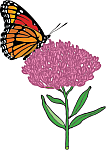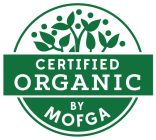What Are Bare Root Perennial Plants?
Seed, potted, plugs, bare root??
Are you confused?
I just want to have a functional garden, you splutter.
I get it. It is hard to know where to start, espcially if you are new to native, medicinal, and edible perennial plants.
But it doesn't have to be hard! Here is my guide to all things perennial plants to help you get off on the right foot and make sure you're buying what is perfect for you!
The four main ways to buy perennial plants
There are many ways to get plants for your garden. Here is a brief overview of your options to help you figure out what is right for you. There are pros and cons to each option.
- POTTED: At a traditional garden center, you typically see plants in larger pots, often half gallon or gallon size pots, growing in soil, sometimes even flowering.
Pros: These are often large plants with a lot of foliage and are available to purchase over a long period of time, spring into summer. You get a big plant and don't have to plan when to get it and it can sit around at your house for a while in it's pot not getting stressed out.
Cons: They can be expensive and also can be "root bound" in their pots from having been sitting there for a while.
- PLUGS: From an online source or catalog, you may be able to buy "plugs" which are a collection of smaller seedling plants in a plastic try, started that spring. They are growing in a little bit of soil and will be much smaller in root mass and foliage stature than plants in pots.
Pros: These can be economical if you want a bunch of a species (or possibly a combo of species) as you are getting many plants at a better price. They are smaller plants
Cons: These are typically available for purchase only at set times of the year most often spring, but sometimes fall. Not a good option if you want one plant or only a few.
- BARE ROOT: From a small farm, nursery or small catalog source (Fedco), you may be able to purchase perennial plants "bare root". That means they are dug from the ground where they overwintered, before there is very much top growth, and the soil is shaken from their roots and provided to you packed in a little bit of moist material (often peat moss) to keep their roots damp.
Pros: Best option for the plants, producing the largest and strongest plants available. These can cost less than potted plants at a nursery due to lower inputs.
Cons: These are only available during a short window of the year, most often in spring but also possibly in the fall. You will need to be ready or close to ready to put them in your garden space.
- SEED: There are many seed companies that deal in native, medicinal, and edible perennial plant seed. The seed can be started in the winter and grown in plug trays in the spring and summer and planted in your garden in the fall to overwinter.
Pros: Starting plants from seed is the most economical way to do things. You can also see the entire lifecycle of a plant, which helps you get to know it better.
Cons: It is slower to get big flowering plants, especially for some species that may require more than one year to flower. It takes more labor and supplies for a longer time, including a place to start the seeds, watering them, the cost of pots, and soil.

What is the process for producing bare root plants at Ripley Farm?
We grow all of our plants from seed, much of which is either collected by us from stock on our farm, or found in the wild harvested sustainably, or bought from a seed company. We start the seeds in late winter and let them grow until they are ready to be planted out into our garden. They grow for a year while we keep the weeds back and lovingly tend them. After overwintering on the farm, our bare root plants are then dug for you in the beginning of their second year.
Producing bare root plants is the way that people used to do it. It is a dying breed as large scale nurseries growing their plants in containers has taken over much of the plant market. Growing bare root plants is labor intensive, but plant friendly.
Bare root perennial plants are usually bigger and stronger than their container grown counterparts.
Bare root plants are more likely to thrive in your garden
We grow bare root plants because we love plants! It's the most natural and close to nature way to grow plants. The benefits of bare root plants are many:
- Bigger, stronger plants more likely to thrive in your garden.
- Plants that have been adapted to growing outside (rather than container grown in a protected greenhouse environment) making them as hardy as they can be.
- Organically grown so you can be sure that there were no chemicals sprayed on them ever! Growing outdoors in the soil, just like they do in nature, makes these plants healthy and without the need for pesticides.
How to Handle and Plant Bare Root Perennials
Our plants come to you bare-root and packed in a little bit of peat moss. Like this:

When to Plant:
- Now, ideally. Bare root plants are happiest in the ground. They should be planted as soon as possible. If immediate planting is not possible, see the storage tips below.
- Unlike greenhouse-grown plants, bare-root plants can be planted during cold weather or anytime the soil is not frozen. These are hardy perennials. Cool and damp spring conditions are just what they need to make a smooth transition to a new home.
How to Handle and Plant Bare Root Perennials
- Remove plants from the bags and completely water all plants to the saturation point and allow for free drainage. This will rehydrate the roots.
- Dig a hole deep enough for the roots to comfortably spread out and/or hang down. A comfortable plant is a happy plant. Fill in around the roots with soil and gently firm them in to settle them in their new home. Try to bring the soil level flush to the top of the crown of the plant, matching the level that the plant previously experienced while growing.
- Once planted, water thoroughly. Water is the chicken soup for a newly transplanted perennial’s soul. Unless conditions are excessively dry or you have very well drained soil one thorough watering at the time of planting is generally sufficient to send your perennial on its way to new growth.
Bare root perennials grow quickly from the stored energy in their roots.
Storage and handling:
If you are unable to plant right away, it is important to keep your plants happy by meeting their basic needs.
Moisture:
Happy bare root perennials are stored to keep the roots:
- Not too dry and desiccating;
- Not too wet and saturated;
Just right (think Goldilocks here), all nice and gently moist. Do not allow the roots to dry out.
Temperature and Light:
Happy bare root perennials like the cool and dark. Ideally, plants should be stored in a refrigerator (34-38° F) before planting. Next best is a cool, shady spot. Warmer temperatures or direct sunlight can cause excessive premature growth or mold in the bag or cause the roots to dry out. Freezing can damage or kill the roots, especially when they’ve already begun to grow.
Air:
A happy bare root perennial can breathe, but doesn’t like drafts. Don’t seal shut the plastic bag. Just leave it loosely shut.
Further Resources for Native, Medicinal, and Edible Plants
- Lady Bird Johnson Wildflower Center https://www.wildflower.org/ based in Texas is a national clearinghouse of information on native plants. They maintain a searchable database by state of native plants for various site conditions at https://www.wildflower.org/plants
- Native Plant Trust (formerly New England Wildflower Society) http://www.nativeplanttrust.org/ based in Massachusetts is a regional goldmine of information on native plants.
- Wild Seed Project https://wildseedproject.net/ based in Maine is a local resource for seeds and information about native plants.
- Prairie Moon Nursery https://www.prairiemoon.com/ is a Minnesota based native plant seed company. If you want to see what different native plants look like, their website and catalog are great resources.
- Strictly Medicinals https://strictlymedicinalseeds.com/ is an Oregon based medicinal plant seed company. The owner, Richo Cech, is also a published author of books about growing and making medicine with medicinal plants that we have and recommend.
- Fedco Trees https://www.fedcoseeds.com/trees/ is a Maine based seed and plant catalog with online sales. They sell native, medicinal, and edible plants for your gardens. They offer some of our perennials.
Ripley Farm's bare root plants are ready to grow for you!
Overall, bare root plants are the most ready to grow of any of the ways you can buy perennial plants. They're not stunted because they've been growing in the same soil for a while in pots like potted plants or small in cells like plugs. They are big, one year old plants that have lived in real organic garden dirt (just like where they're going) that are ready for what you want them to do for you, whether it's:
- feed the pollinators,
- grow medicine for you,
- or provide you actual food year after year.
You really can change the world by starting in your own backyard.
Do you have any questions about bare root plants that I didn't discuss here? Reply and let me know.
We can't wait to help you enhance the diversity of your own little piece of earth!



Add new comment